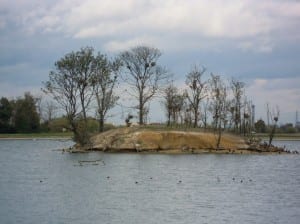Drinking the toilet water
By ucesbar, on 15 October 2013
This week we are happy to feature a guest blog from Emma M. Jones, author of Parched City, an account of London’s drinking water published by Zero Books earlier this year (http://www.zero-books.net/books/parched-city):
Equating tap water with toilet water may seem incongruous but in most homes they are indeed one and the same. ‘Tap’ water sounds good to cook with, to brush our teeth with, or even to shower under while taking the odd, if inadvertent, sip. ‘Toilet’ water, as ‘tap’ water soon becomes when it flows into that essential piece of technology, seems fit only to sluice our bodily waste away; once the toilet has bacteriologically degraded the fluid from potable to a health hazard. Yet, seconds prior to the moment that it encountered the site of our daily defecation, the same water destined for the flush should have been as safe and wholesome as the law dictates to make the drinking grade.
Like the convenors of UCLoo Festival (opening on World Toilet Day, 19th November), I concur on the absurdity of this fact: ‘In London alone, more than 400 million litres of drinking water are flushed down the toilet every day.’ Reader, perhaps you are a pioneering greywater enthusiast, who has rigged dual water systems in your home at great expense. I think I am fairly safe in assuming, though, that the majority of us tend to rely on a sole plumbing system, which serves all our water-related needs. Drinking water is, therefore, for most daily users simply all water. To legally qualify as suitable for ‘domestic purposes’[1] – cooking, drinking, food preparation, washing – our tap water will have been through quite an ordeal.

Metropolitan Water Board’s Department of Water Examination, built 1938, Islington (now private housing).
From raw water’s underground or river source (the latter is more highly treated given its volatile environment), the liquid will first be channeled into a reservoir. Initially, even the decision to let supplies into this storage space may be timed to avoid pollution known to be travelling downstream, facilitated by a well-oiled communication system between the water industry and the Environment Agency. Once captured, the greatest proportion of water’s journey to potable will be made simply by settling for a period of time, which can last for weeks. A leading water scientist suggested to me that this natural process, though facilitated by the artificial space of a man-made lake, makes up 90% of water treatment – simply by adding the essential ingredients of time and space.[2] This elegant truth about the efficacy of the storage factor on producing safe drinking water was established in the first decade of the 20th century by the bacteriologist Alexander Houston, of the Metropolitan Water Board, and continues to be applied to London’s water treatment today.[3]
What has changed since Houston’s day is the sophistication of how water quality is measured, to detect minute traces of pesticides, for instance. Post-reservoir, the remaining 10% of water treatment involves an extensive à la carte menu of engineering and chemical interventions, including: aeration, ammonia, clarification, slow-sand filtration, ozonation, ultra-violet treatment, chlorination, granular activated carbon and reverse osmosis. Expert tasters, and sniffers, are also on hand to perform their duties, as are microbiologists and chemists who check the product, to ensure that what leaves the water treatment facility should be in a state to remain drinkable when it reaches our kitchen taps, and acceptable to us (a key concept).
Of all the things we use drinking-quality water for, flushing the loo has to be the most wasteful. Would we flush bottled water down the toilet? There is a vast monetary gulf between the drinking water we find in corner-shop fridges and the product from our taps, but both are the same precious freshwater resource that requires intense labour and material resources to produce. Tap water is not on the free market like bottled water, though in essence it is the same product.
Given the sophisticated engineering infrastructure and scientific expertise that has been honed over two centuries to allow London, other world cities and many nations to produce water at drinking quality standards agreed with the World Health Organization, the UCLoo Festival’s proposals to save this resource for its intended purpose seem very wise to me.
I hope the current systemic stasis in the use of water can be ruffled by this festival’s daring design proposals, and I look forward to joining that queue to spend a penny in a dry-dock loo and giving my tuppence-worth on the experience of toileting without water.
*Please consider making a small donation to our fundraising drive at http://spacehive.com/ucloofestival2013. We have almost reached our target, but need your help to make sure this important conversation happens!
You can also find more information about the UCLoo Festival, running 19th Nov. – 3rd Dec. at UCL’s Bloomsbury campus, through our Twitter (@UClooFestival) and Facebook (https://www.facebook.com/ucloofestival) accounts.
 Close
Close



